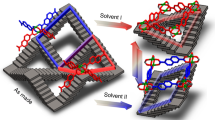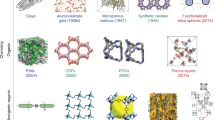Abstract
Porous coordination polymers, in particular flexible porous coordination polymer networks that change their network structure on guest adsorption, have enormous potential in applications involving selective storage, separation and sensing. Despite the expected significant differences in their adsorption properties, porous coordination polymer nanocrystals remain largely unexplored, and there have been no reports about studies on flexible porous coordination polymer nanocrystals, mainly due to a lack of preparation methods. Here, we present a new technique for the rapid preparation of porous coordination polymer nanocrystals that combines non-aqueous inverse microemulsion with ultrasonication. Uniform nanocrystals of {[Zn(ip)(bpy)]}n (ip = isophthalate, bpy = 4,4′-bipyridyl; CID-1), a flexible porous coordination polymer, have been prepared by this method and analysed using field-emission scanning electron microscopy, energy-dispersive X-ray analysis, infrared spectroscopy, Raman spectroscopy and X-ray powder diffraction. A model for particle formation and growth is presented and discussed. Adsorption experiments with methanol show that the overall adsorption capacities of nanoparticles and bulk are almost identical, but the shapes of the sorption isotherms differ significantly and the adsorption kinetics increase dramatically.
This is a preview of subscription content, access via your institution
Access options
Subscribe to this journal
Receive 12 print issues and online access
$259.00 per year
only $21.58 per issue
Buy this article
- Purchase on Springer Link
- Instant access to full article PDF
Prices may be subject to local taxes which are calculated during checkout





Similar content being viewed by others
References
Férey, G. Hybrid porous solids: past, present, future. Chem. Soc. Rev. 37, 191–214 (2008).
Mueller, U. et al. Metal–organic frameworks—prospective industrial applications. J. Mater. Chem. 16, 626–636 (2006).
Rosseinsky, M. J. Recent developments in metal–organic framework chemistry: design, discovery, permanent porosity and flexibility. Microporous Mesoporous Mater. 73, 15–30 (2004).
Maspoch, D., Ruiz-Molina, D. & Veciana, J. Magnetic nanoporous coordination polymers. J. Mater. Chem. 14, 2713–2723 (2004).
Yaghi, O. M. et al. Reticular synthesis and the design of new materials. Nature 423, 705–714 (2003).
Kitagawa, S., Kitaura, R. & Noro, S. Functional porous coordination polymers. Angew. Chem. Int. Ed. 43, 2334–2375 (2004).
Zacher, D., Shekhah, O., Woell, C. & Fischer, R. A. Thin films of metal–organic frameworks. Chem. Soc. Rev. 38, 1418–1429 (2009).
Furukawa, S. et al. Heterogeneously hybridized porous coordination polymer crystals: fabrication of heterometallic core–shell single crystals with an in-plane rotational epitaxial relationship. Angew. Chem. Int. Ed. 48, 1766–1770 (2009).
Gadzikwa, T. et al. Covalent surface modification of a metal–organic framework: selective surface engineering via Cu(I)-catalyzed Huisgen cycloaddition. Chem. Commun. 5493–5495 (2008).
McHale, J. M., Auroux, A., Perrotta, A. J. & Navrotsky, A. Surface energies and thermodynamic phase stability in nanocrystalline aluminas. Science 277, 788–791 (1997).
Zhang, H. Z., Gilbert, B., Huang, F. & Banfield, J. F. Water-driven structure transformation in nanoparticles at room temperature. Nature 424, 1025–1029 (2003).
Czaja, A. U., Trukhan, N. & Mueller, U. Industrial applications of metal–organic frameworks. Chem. Soc. Rev. 38, 1284–1293 (2009).
Lin, W., Rieter, W. J. & Taylor, K. M. L. Modular synthesis of functional nanoscale coordination polymers. Angew. Chem. Int. Ed. 48, 650–658 (2009).
Spokoyny, A. M., Kim, D., Sumrein, A. & Mirkin, C. A. Infinite coordination polymer nano- and microparticle structures. Chem. Soc. Rev. 38, 1218–1227 (2009).
Ni, Z. & Masel, R. I. Rapid production of metal–organic frameworks via microwave-assisted solvothermal synthesis. J. Am. Chem. Soc. 128, 12394–12395 (2006).
Zong-Qun Li, L.-G. Q. et al. Ultrasonic synthesis of the microporous metal–organic framework Cu3(BTC)2 at ambient temperature and pressure: an efficient and environmentally friendly method. Mater. Lett. 63, 78–80 (2009).
Rieter, W. J., Taylor, K. M. L., An, H., Lin, W. & Lin, W. Nanoscale metal–organic frameworks as potential multimodal contrast enhancing agents. J. Am. Chem. Soc. 128, 9024–9025 (2006).
Taylor, K. M. L., Jin, A. & Lin, W. Surfactant-assisted synthesis of nanoscale gadolinium metal–organic frameworks for potential multimodal imaging. Angew. Chem. Int. Ed. 47, 7722–7725 (2008).
Hermes, S. et al. Trapping metal–organic framework nanocrystals: an in situ time-resolved light scattering study on the crystal growth of MOF-5 in solution. J. Am. Chem. Soc. 129, 5324–5325 (2007).
Tsuruoka, T. et al. Nanoporous nanorods fabricated by coordination modulation and oriented attachment growth. Angew. Chem. Int. Ed. 48, 4739–4743 (2009).
Férey, G. & Serre, C. Large breathing effects in three-dimensional porous hybrid matter: facts, analyses, rules and consequences. Chem. Soc. Rev. 38, 1380–1399 (2009).
Bradshaw, D., Warren, J. E. & Rosseinsky, M. J. Reversible concerted ligand substitution at alternating metal sites in an extended solid. Science 315, 977–980 (2007).
Suh, M. P. & Cheon, Y. E. Recent advances in the dynamics of single crystal to single crystal transformations in metal–organic open frameworks. Aust. J. Chem. 59, 605–612 (2006).
Kepert, C. J. Advanced functional properties in nanoporous coordination framework materials. Chem. Commun. 695–700 (2006).
Fletcher, A. J., Thomas, K. M. & Rosseinsky, M. J. Flexibility in metal–organic framework materials: impact on sorption properties. J. Solid State Chem. 178, 2491–2510 (2005).
Uemura, K., Matsuda, R. & Kitagawa, S. Flexible microporous coordination polymers. J. Solid State Chem. 178, 2420–2429 (2005).
Kondo, A. et al. Double-step gas sorption of a two-dimensional metal–organic framework. J. Am. Chem. Soc. 129, 12362–13263 (2007).
Llewellyn, P. L., Bourrelly, S., Serre, C., Filinchuk, Y. & Férey, G. How hydration drastically improves adsorption selectivity for CO2 over CH4 in the flexible chromium terephthalate MIL-53. Angew. Chem. Int. Ed. 45, 7751–7754 (2006).
Li, J. R., Kuppler, R. J. & Zhou, H. C. Selective gas adsorption and separation in metal–organic frameworks. Chem. Soc. Rev. 38, 1477–1504 (2009).
Tanaka, D. & Kitagawa, S. Template effects in porous coordination polymers. Chem. Mater. 20, 922–931 (2008).
Horcajada, P. et al. Flexible porous metal–organic frameworks for a controlled drug delivery. J. Am. Chem. Soc. 130, 6774–6780 (2008).
Tanaka, D. et al. Kinetic gate-opening process in a flexible porous coordination polymer. Angew. Chem. Int. Ed. 47, 3914–3918 (2008).
Uemura, T., Hoshino, Y., Kitagawa, S., Yoshida, K. & Isoda, S. Effect of organic polymer additive on crystallization of porous coordination polymer. Chem. Mater. 18, 992–995 (2006).
Horcajada, P. et al. Colloidal route for preparing optical thin films of nanoporous metal–organic frameworks. Adv. Mater. 21, 1931–1935 (2009).
Farha, O. K. et al. Gas-sorption properties of cobalt(II)–carborane-based coordination polymers as a function of morphology. Small 5, 1727–1731 (2009).
Lee, H. J., Cho, W., Jung, S. & Oh, M. Morphology-selective formation and morphology-dependent gas-adsorption properties of coordination polymer particle. Adv. Mater. 21, 674–677 (2008).
Horike, S., Tanaka, D., Nakagawa, K. & Kitagawa, S. Selective guest sorption in an interdigitated porous framework with hydrophobic pore surfaces. Chem. Commun. 3395–3397 (2007).
Riter, R. E., Kimmel, J. R., Undiks, E. P. & Levinger, N. E. Novel reverse micelles partitioning nonaqueous polar solvents in a hydrocarbon continuous phase. J. Phys. Chem. B 101, 8292–8297 (1997).
Novaira, M., Moyano, F., Biasutti, M. A., Silber, J. J. & Correa, N. M. An example of how to use AOT reverse micelle interfaces to control a photoinduced intramolecular charge-transfer process. Langmuir 24, 4637–4646 (2008).
Vaucher, S., Fielden, J., Li, M., Dujardin, E. & Mann, S. Molecule-based magnetic nanoparticles: synthesis of cobalt hexacyanoferrate, cobalt pentacyanonitrosylferrate, and chromium hexacyanochromate coordination polymers in water-in-oil microemulsions. Nano Lett. 2, 225–229 (2002).
Vaucher, S., Li, M. & Mann, S. Synthesis of Prussian blue nanoparticles and nanocrystal superlattices in reverse microemulsions. Angew. Chem. Int. Ed. 39, 1793–1796 (2000).
Eastoe, J., Hollamby, M. J. & Hudson, L. Recent advances in nanoparticle synthesis with reversed micelles. Adv. Colloid Interface Sci. 128–130, 5–15 (2006).
Pileni, M.-P. The role of soft colloidal templates in controlling the size and shape of inorganic nanocrystals. Nature Mater. 2, 145–150 (2003).
Zacher, D., Liu, J. N., Huber, K. & Fischer, R. A. Nanocrystals of [Cu3(btc)2] (HKUST-1): a combined time-resolved light scattering and scanning electron microscopy study. Chem. Commun. 1031–1033 (2009).
Rowsell, J. L. C. & Yaghi, O. M. Metal–organic frameworks: a new class of porous materials. Microporous Mesoporous Mater. 73, 3–14 (2004).
Chen, B. et al. Surface interactions and quantum kinetic molecular sieving for H2 and D2 adsorption on a mixed metal–organic framework material. J. Am. Chem. Soc. 130, 6411–6423 (2008).
Sing, K. S. W. et al. Reporting physisorption data for gas solid systems with special reference to the determination of surface-area and porosity. Pure Appl. Chem. 57, 603–619 (1985).
Katcho, N. A. et al. Carbon hollow nanospheres from chlorination of ferrocene. Chem. Mater. 19, 2304–2309 (2007).
Tanaka, D. & Kitigawa, S. in Chobunshi Kirzoku Sakutai (eds Fujita, M. & Shionoya, M.) 317 (Sankyo-Shuppan, 2009).
Acknowledgements
The authors thank R. Matsuda, H. Sato and H. Sakamoto for their guidance with XRPD measurements, S. Singh, S. Furukawa and T. Tsuruoka for helpful discussions, and N. Yanai for his practical help. Thanks also go to S. Ruetten and K.H. Phan for their kind help with the measurements for FE-SEM, W. Richtering for experimental support regarding dynamic light scattering, and W. Tillmann for carrying out the IR and Raman spectrum measurements. This work was supported by the Exploratory Research for Advanced Technology (ERATO) ‘Kitagawa Integrated Pore Project’ of the Japan Society and Technology Agency (JST).
Author information
Authors and Affiliations
Contributions
D.T., S.K. and J.G. conceived and designed the experiments. D.T., A.H. and K.N. performed the experiments. D.T., A.H., K.N., K.A. and J.G. analysed the data. D.T., A.H., K.A., M.M., S.K. and J.G. contributed to writing the paper. All authors contributed to the optimization of the experiments.
Corresponding authors
Ethics declarations
Competing interests
The authors declare no competing financial interests.
Supplementary information
Supplementary information
Supplementary information (PDF 610 kb)
Rights and permissions
About this article
Cite this article
Tanaka, D., Henke, A., Albrecht, K. et al. Rapid preparation of flexible porous coordination polymer nanocrystals with accelerated guest adsorption kinetics. Nature Chem 2, 410–416 (2010). https://doi.org/10.1038/nchem.627
Received:
Accepted:
Published:
Issue Date:
DOI: https://doi.org/10.1038/nchem.627
This article is cited by
-
Diverse crystal size effects in covalent organic frameworks
Nature Communications (2020)
-
Simultaneous interlayer and intralayer space control in two-dimensional metal−organic frameworks for acetylene/ethylene separation
Nature Communications (2020)
-
Control of structural flexibility of layered-pillared metal-organic frameworks anchored at surfaces
Nature Communications (2019)
-
Green synthesis, activation and functionalization of adsorbents for dye sequestration
Environmental Chemistry Letters (2019)
-
Real-time observation of cation exchange kinetics and dynamics at the muscovite-water interface
Nature Communications (2017)



